
Product test
Review: the Tanita RD-545 body composition scale
by Patrick Bardelli

I’m fed up with my belly flab. Time to get rid of it once and for all. For this attempt, I’m getting help from science.
Last summer, I found out why my quest for a six-pack is doomed. Sure, too much of the wrong things on my plate are not helping. However, that’s only half of it. There are more reasons for my abdominal fat.
I have been sporting a paunch for a long time. By contrast, my contact at ETH Zurich is relatively new. Claudio Viecelli is a molecular and muscle biologist there. I met him on a hunt last autumn. Now, I’m sitting in an office and am marvelling at an impressive piece of furniture by General Electric – the Lunar iDXA. That stands for «Dual-energy X-ray Absorptiometry». I’ve yet to find out what that means exactly. Claudio is in charge of digitalising the fitness studio at Irchel Campus. The data generated there will be used for his research in the field of muscle physiology. His area of expertise is exploring efficient and effective strength training strategies to increase muscle mass.
What does the data tell you?
Claudio Viecelli, molecular and muscle biologist at ETH Zurich:
New technologies, such as sensors, allow us to record strength training with much greater precision. To be able to quantify and compare a stimulus in the first place, we need to describe it with scientific accuracy. It’s not enough to simply describe a weightlifting workout in terms of the number of sets and repetitions made. For the first time ever, digitalisation allows us to record strength training very precisely and to analyse it accordingly. Based on that data, workout plans can be adapted to better suit individual needs.
Why does this require a body analysis using X-rays?
Firstly, this method is much more accurate than the well-known bioelectric impedance analysis, or BIA for short. And secondly, I personally need as much accurate data as possible for my research. The study I’m involved in aims to carry out three body composition measurements. One is done before the study is launched, one in the middle and one at the end of the study. First off, the subjects’ bodies are analysed. Then the subjects work out on the digitalised machines. This allows us to draw conclusions about the changes in body composition induced by strength training. The strength training data helps us understand the training strategy.
How is this General Electric device different from your standard medical body composition monitor such as Tanita or InBody?
Those machines measure resistance by sending a small electrical current through your body. We use X-rays with two different energies. The X-rays meet the surface of the object and pass through it. The intensity of the rays when they exit depends on the length, absorption and/or scattering effect of the object they’ve passed through. The radiation exponentially decreases and is less strong when it exits compared to when it enters. Because of the different atom sizes of the elements, they now each have a specific damping coefficient per energy. As we use two different energies, we get different damping coefficients, which we can then put into relation. These ratios are different for each individual element. Therefore, we are able to quantify the atomic and/or molecular composition of a radiated object.
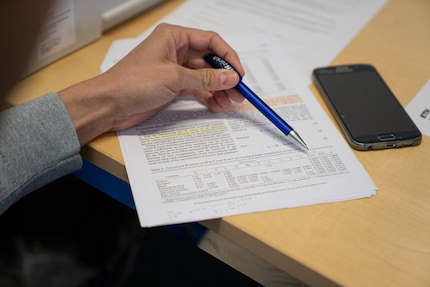

How is that calculated exactly?
Let's say you send 40 and 70 kiloelectron volts through an atom. This gives you different damping and therefore different damping coefficients. Now you put the different damping coefficients in proportion and get a value of, for example, 1.2906 for a protein molecule. The machine does this for every one of your molecules. This method gives you a value for protein, sugar, water, etc. Based on this data you can then make a statement about the composition.
Isn’t that pretty much what BIA does? An electrical current is sent through your body via the hands and feet and measures resistance. Bones are more resistant than muscles. Muscles are more resistance than fat, and so on and so forth.
True, but this machine here is very accurate. If we were to measure you twice in a row on the DXA in a different position, the difference would only be about one percentage point. With the BIA, the difference would be up to five percentage points. So what we have here is the gold standard in body analysis.
Who is this designed for? After all, we’re talking about an investment of about 100,000 francs. To put this into perspective: A medical BIA scale is about ten times cheaper.
The Federal Office of Sport, for example, carries out DXA measurements with its athletes. Personally, I find it interesting to scientifically monitor my progress. Naturally, this only makes sense if you have certain athletic ambitions and apply an appropriate method in the gym. And yes, this would be a huge investment for a gym.
Well then. Opportunity makes an analysis. While I’m here, I might as well lay down on the X-ray machine and have myself scanned. But first, I need to have a word with Claudio about radiation. «Don’t worry,» is all he says. One day in the Graubünden mountains, and I’d be exposed to roughly the same amount of radiation. The radiation is about 1/6 of a transatlantic flight. In that case, let’s take off! It takes about five minutes for my body to be analysed.
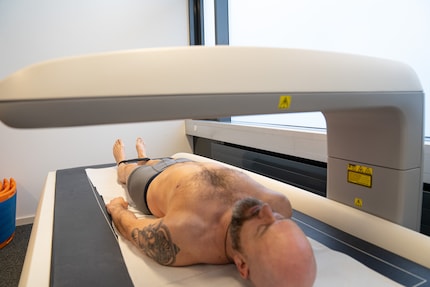
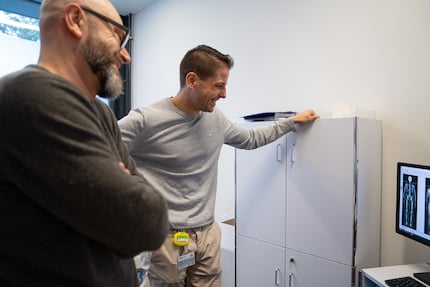
And what do the bare figures say? General Electric collected data from a reference group in the US. This serves as a comparative figure. I just about make the first third in my age group. Put in simple terms: about 65 per cent of the reference group show a «worse» body composition. This means more weight, a worse BMI, more body fat and less lean muscle mass. I can definitely live with that. What I struggle with is my body fat percentage of 28.4 per cent. I beg your pardon?! The last measurement in June 2019 with an InBody 720 showed a body fat percentage of 17.8 per cent at almost the same weight. Where the hell did ten per cent fat suddenly come from? It’s not like my love handles have grown. Claudio has found a possible cause.
«Your left leg weighs one kilo less than your right one. However, its fat content is two per cent higher.» I’m impressed. I had a knee operation in December. A damaged cartilage. Before and since that operation, I haven’t been able to put my full weight on it. This has been going on for months. Yep, Claudio’s explanation makes sense. What about the remaining difference? «Remember that this is the gold standard,» Claudio says. «It’s likely that the InBody just isn’t that exact,» he adds with a grin.
Right then. This means that the next few months will be all about reducing fat and building muscles. In other words, lifting weights and paying even more attention to what I eat. I’ve picked the right season for this endeavour and hope to have a beach bod by the summer. And I want that six pack. «Any idea how many kilocalories are equal to one gramme of fat?» Claudio yanks me out of my six pack daydream. I have no idea. And frankly, I've never given it any thought. It’s a good thing there’s a scientist in the room. One gramme of fat equals 9 kcal.
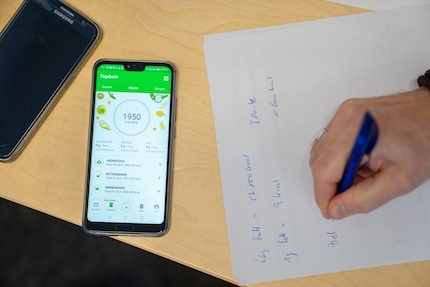
So if I want to get rid of six kilos of fat, that would be about 54,000 kcal. Human fat cells also consist of proteins and water and their pure fat content is only about 80 to 90 per cent. But for sake of simplicity, we calculated 9 kcal per gramme of fat. «Over what period of time do you want to reduce your fat?» Claudio asks me. Let’s say 90 days? This would mean a daily calorie deficit of 600 kcal. My food track app says I’m allowed to eat 1,950 kcal a day without putting on more weight in the long run. In other words, I’m allowed 1,350 kcal a day. Blimey, that’s hardly anything. In that case, I’ll spread out the deficit over 150 days. That’s 360 kcal minus per day. Hopefully, I’ll manage to live on just under 1,600 kcal a day. I’ll definitely try.
And what does Claudio Viecelli of ETH Zurich have to say about my project? «Six kilos of fat in five months? With a little discipline, you can do it. We’ll be seeing each other at the end of June for another measuring session. Then we'll see how the composition has changed.»
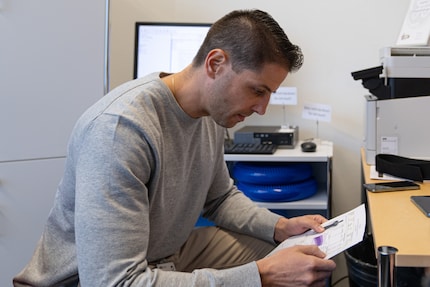
Follow my 54,000 kilocalories of belly fat meet their doom! Click here to view my lean and mean author profile.
From radio journalist to product tester and storyteller, jogger to gravel bike novice and fitness enthusiast with barbells and dumbbells. I'm excited to see where the journey'll take me next.
Interesting facts about products, behind-the-scenes looks at manufacturers and deep-dives on interesting people.
Show all